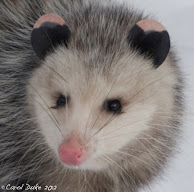Flower Hill is fully leafed out now and birds are busy nesting in all the trees and shrubs. The serpentine native Black Cherry between the birches is where the Orioles are nesting again.
The cluster plantings of shrubberies is a favorite for many songbirds.
A Baltimore Oriole calling out . . . his unique notations fill the garden. Deep smiles fill my heart for their return.
When not calling or helping his mate, he is busy gleaning here and there from the trees and shrubberies.
It is supposed that only the female weaves the nest, but I have seen on more than one occasion the male helping her out . . . rather like someone holding a skein of yarn for another to make it into a ball.
Weaving their nest almost in the exact location as last year amongst the blooming native Black Cherry blossoms. 'Michael's Tree' is out in an open field and is quite tall . . . just the sort of habitat Baltimore Orioles love.
What a feat! How do they learn to be so skilled in weaving . . . fascinating. The female is leaving to gather more materials no doubt. Her coloring is a bit more yellow orange.
All around these birds the gardens are moving into their purposes. Now the south garden focus of Wisteria, Viburnums and early Lilac blooms is fading into . . .
the weeping Japanese Maple and mid east gardens behind the house and barn studio.
The foliage hue is mirrored throughout this garden. My funky pink English Hawthorn is just fading.
Miss Kim and the foliage of a Crabapple compliment the cut-leaf Japanese Maple's wine colored leaves. Japanese Tree Lilac in the background will soon be covered with clouds of white blooms.
Miss Kim and other late blooming Lilacs not quite fully open . . . both were flattened by the heavy winter snow . . . Miss Kim proved the more supple.
Todays wildlife colors of striking orange and black continue in the American Redstart, who is nesting in the Crabapple orchard.
They dart about so much spreading their tail and wings to startle insects out from under leaves and such. It is very hard to get a shot like this one! This two year old is smaller than a goldfinch, while the Baltimore Oriole is about the size of a Robin. It takes two years for both males to attain their bold colors. This little fellow can be polygynous finding a second mate once the first is incubating her eggs.

Here the more subtle female . . . note the yellow coloring along her tail, side of breast and wings.
Look how camouflaged she is here.., the female and young are protected in this way. If you would like to hear their songs and learn more about these beautiful birds, visit 'All About Birds' .
To end our orange and black sharing or in this case more brown and red-orange. . . a Red Admiral is still enjoying the fading Lilac blooms. Their caterpillars prefer to munch on nettle and will bring two leaves together to form an enclosure. I have read that they sometimes fly around at night. I too love the night garden!
It is a great joy for me that the gardens are a habitat to so many birds and butterflies, though I worry for the flutterbys! I get as excited about their return . . . as with any flowers I grow.












































































































































